Practice Exercises - Ecology - AP Biology Premium 2024
Practice Questions
Multiple-Choice
Questions 1 and 2
Refer to the following food web.
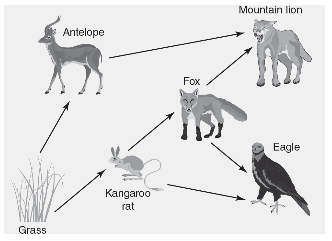
1. What is a role of the fox in this food web?
(A) producer
(B) primary consumer
(C) secondary consumer
(D) tertiary consumer
2. The application of rat poison in the area results in the elimination of the kangaroo rat population. Which of the following is the most likely effect of this event?
(A) The biomass of the producers will increase.
(B) The number of foxes in the ecosystem will likely increase.
(C) The amount of food available to the antelope will decrease.
(D) The mountain lions will eat fewer antelopes and more eagles.
________________________________________________________________________
(A) 90% of the nutrients are lost in each transfer to the next trophic level.
(B) 90% of the energy is lost in each transfer to the next trophic level.
(C) Decomposers can efficiently recycle nutrients for up to four trophic levels.
(D) The biomass at the producer level cannot exceed the biomass at the primary consumer level.
4. Coyotes are a predator of skunks. Coyote urine has a strong scent and is marketed as a skunk repellent. Which type of signal is coyote urine?
(A) audible
(B) chemical
(C) tactile
(D) visual
5. Which of the following is an example of a physiological response to a stimulus?
(A) A female bird moves toward a male bird that is singing an appropriate mating song.
(B) A predator avoids a brightly colored frog in the rain forest.
(C) A bear slows its metabolism in response to shortened day lengths and cooler temperatures.
(D) A primate grooms its offspring.
6. Why are the metabolic rates of smaller organisms generally higher than those of larger organisms?
(A) Smaller organisms have shorter life spans and therefore must accomplish more activities in less time. This requires a faster metabolic rate.
(B) Smaller organisms have a higher surface area to volume ratio than larger organisms and lose more heat to the environment.
(C) Smaller organisms are more likely to be ectothermic than larger organisms and therefore need a higher metabolic rate to compensate for this.
(D) Smaller organisms consume less food per gram of body weight than larger organisms and therefore need a higher metabolic rate to compensate for this.
Questions 7 and 8
Refer to the following food web. The arrows show the direction of the flow of energy, and species are represented by roman numerals.
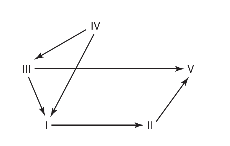
7. Which species in this food web is most likely a producer?
(A) I
(B) II
(C) III
(D) IV
8. Which species is both a primary consumer and a secondary consumer?
(A) I
(B) II
(C) III
(D) IV
______________________________________________________________________________
The respiration rate (as measured by oxygen consumption per gram of body weight per minute) was measured in rats, grasshoppers, and newly discovered species animal X. The respiration rates were measured at 5°C and 30°C for all three species. Data are shown in the table.
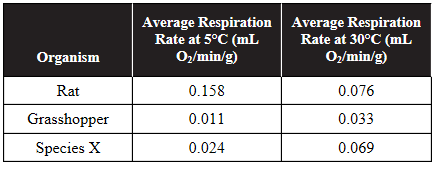
9. Which of the following conclusions about species X is best supported by the data?
(A) Species X is ectothermic since its respiration rate is higher at a higher environmental temperature.
(B) Species X is ectothermic since ectothermic animals always have an increased respiration rate at lower temperatures.
(C) Species X is endothermic since its respiration rate at 30°C is closer to the respiration rate of the rat at 30°C than to the respiration rate of the grasshopper at 30°C.
(D) Species X is endothermic since its respiration rate is higher at a higher environmental temperature.
10. This experiment is repeated with the same animals at a temperature of 37°C. Which of the following is the most likely result?
(A) The rat will have a higher respiration rate than the grasshopper at 37°C because rats are ectothermic.
(B) The grasshopper will have a higher respiration rate than species X at 37°C because grasshoppers are ectothermic and species X is endothermic.
(C) Species X will have a higher respiration rate than the rat at 37°C because rats are ectothermic and species X is endothermic.
(D) The rat will have a lower respiration rate than both the grasshopper and species X at 37°C because rats are endothermic and both grasshoppers and species X are ectothermic.
Short Free-Response
11. The following table shows the diet composition of members of an estuarine ecosystem (a shallow, coastal shelf where a freshwater river empties into a larger saltwater body). Higher percentages indicate a higher degree of reliance on a particular food source. An “X” indicates that the source is not a food source for that organism.
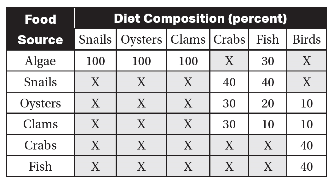
(a) Describe the role of algae in this ecosystem.
(b) Represent the relationships between these organisms by constructing a food web for this ecosystem.
(c) Identify the secondary consumers in this ecosystem.
(d) Predict the organism in this ecosystem that will have the lowest biomass. Explain why you made this prediction.
12. In order to investigate the possible effects that chemicals in a certain insecticide have on plant growth, a researcher grew 100 plants from each of three different crop species. Fifty plants of each type were grown in a lab in the presence of the insecticide, and the other 50 plants of each type were grown in a lab without insecticide. All plants were grown to maturity and then dried, and the mean dry weight per plant and the standard error of the mean were calculated for each group. Data are shown in the table.
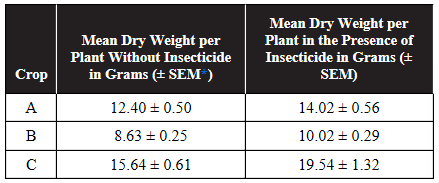
*Standard Error of the Mean
(a) Describe the effect of the use of the insecticide on the mean dry weight of crop B.
(b) Calculate which crop (A, B, or C) had the greatest percent increase in mean dry weight in the presence of the insecticide. Show your work.
(c) The researcher makes the claim that use of this insecticide increases the mean dry weight of all three crops. Using the data from the table, evaluate the researcher’s claim.
(d) Explain why the use of an insecticide could increase the yield of some agricultural crops.
Long Free-Response
13. Plants thought to have evolved in temperate climates use C3 photosynthesis (also known as the light-independent cycle). Plants thought to have evolved in tropical climates use an additional step referred to as C4 photosynthesis. Scientists measured the photosynthetic rate of C3 plants (sugar beets) and C4 plants (sugarcane) in a sealed container under three different temperature conditions. Data are shown in the table.
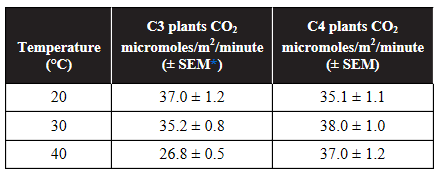
*Standard Error of the Mean
(a) Explain why the rate of carbon dioxide consumption was used in this experiment.
(b) Construct a graph of the data, showing 95% confidence intervals.

(c) Analyze the data, and determine at which temperature(s) there was a statistically significant difference in carbon dioxide consumption in C3 and C4 plants.
(d) Coleus is a popular C3 houseplant. A person has a Coleus plant inside her climate-controlled home, in which the temperature never exceeds 30° Celsius. If this plant was placed outside for seven days during a heat wave (in which the high temperature each day reached 39°C), predict the effect this would have on the plant. Justify your prediction.
Practice Questions
Multiple-Choice
Questions 1 and 2
Refer to the figure, which shows the population of wild rabbits on an island as time progresses.
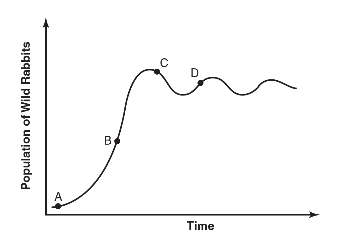
1. Which of the following best represents a time when the rabbit population was experiencing exponential growth?
(A) A
(B) B
(C) C
(D) D
2. Which of the following points best approximates the carrying capacity of the island for rabbits?
(A) A
(B) B
(C) C
(D) D
____________________________________________________________________________
(A) 135
(B) 141
(C) 145
(D) 152
4. In 1986, the quail population in Golden Gate Park in San Francisco was 140 birds. Hunting by feral cats reduced the number of quail to 32 birds by 2016. If the birth rate of quail over this period averaged 20.4 quail/year, what was the average death rate of quail during this period?
(A) 2.4 quail/year
(B) 3.6 quail/year
(C) 24 quail/year
(D) 36 quail/year
5. A population of 190 jackrabbits lives in McInnis Park in San Rafael, California. The carrying capacity of the park for jackrabbits is approximately 200 rabbits. If the rmax for the jackrabbit population is 1.5 surviving jackrabbits per year, what is the estimated increase in the number of jackrabbits in one year?
(A) 10
(B) 14
(C) 285
(D) 300
6. Which of the following statements describes a population that could experience exponential growth?
(A) a population that was limited by density-dependent factors
(B) a population whose size is beyond the carrying capacity of the environment
(C) a population in which there are no limiting factors
(D) a K-selected population
7. Acacia ants (Pseudomyrmex ferruginea) live on acacia trees (Vachellia cornigera). The ants obtain food and shelter from the acacia trees, and the ants drive away animals that would otherwise eat the leaves of the acacia trees. Which of the following best describes the relationship between Pseudomyrmex ferruginea and Vachellia cornigera?
(A) niche partitioning
(B) commensalism
(C) mutualism
(D) parasitism
8. Two species of lynx spiders, Peucetia rubrolineata and Peucetia flava, both inhabit the plant Trichogoniopsis adenantha, a type of sunflower found in Brazil. However, Peucetia rubrolineata inhabit plants in shaded areas, while Peucetia flava inhabit plants in open areas. This is an example of
(A) competition.
(B) mutualism.
(C) niche partitioning.
(D) predator/prey relationship.
9. Cytisus scoparius, also known as Scotch broom, was introduced into California from England in the mid-1800s as an easy-to-grow plant that helped stabilize soil on the hillsides. One Scotch broom plant can produce over 12,000 seeds a year. Scotch broom forms a dense shade canopy that prevents seedlings of other plants from growing. There are no natural predators for Scotch broom in California since its leaves are toxic to most animal species. Which of the following most accurately describes Scotch broom’s role in the California ecosystem?
(A) keystone species
(B) invasive species
(C) mutualistic species
(D) native species
10. Tidal marshland A, which is adjacent to the San Francisco airport, has a Simpson’s Diversity Index of 0.65. Tidal marshland B, which is two miles from the airport, has a Simpson’s Diversity Index of 0.80. An oil spill occurs at a location at the halfway point between the two marshlands. If both marshlands are equally contaminated by the oil spill, which marshland is more likely to recover from the oil spill?
(A) Tidal marshland A is more likely to recover, because its lower Simpson’s Diversity Index means that few species will be affected.
(B) Tidal marshland B is more likely to recover, because its higher Simpson’s Diversity Index means it has a wider variety of species and can better absorb the effects of a disturbance.
(C) Both ecosystems will be equally affected, because they are the same distance from the oil spill.
(D) Neither ecosystem will be able to recover, because oil is toxic to all organisms.
Short Free-Response
11. A population of 45 geese are introduced to a lake. The birth rate of the population is 0.28 geese per year, and the death rate is 0.18 geese per year.
(a) Calculate the rate of population growth.
(b) Determine whether the population of geese is increasing or decreasing.
(c) The carrying capacity for geese at this lake is about 80 geese. Make a prediction about the population of geese relative to the lake’s carrying capacity for geese in the next 10 years.
(d) Justify your prediction from part (c).
12. On an island north of the Arctic Circle, the Arctic fox preys upon puffins, and puffins consume Arctic grass.
(a) Identify the trophic levels to which the Arctic fox, puffin, and Arctic grass belong.
(b) Explain why the number of Arctic foxes on this island will most likely be less than the number of puffins in a healthy ecosystem.
(c) Predict the effect that the elimination of all Arctic foxes on this island would have on the puffins and Arctic grass.
(d) Justify your prediction from part (c).
Long Free-Response
13. Largemouth bass (Micropterus salmoides) eat dace fish (Leuciscus leuciscus). Dace fish eat daphnia. Daphnia eat algae in the lake. The number of largemouth bass and dace fish in a lake are recorded over a 10-year period. At year 5, great blue herons (Ardea herodias) are introduced to the lake. Great blue herons feed on young largemouth bass. The following graph shows the data regarding the relative population sizes of the largemouth bass and dace fish over the 10-year period.
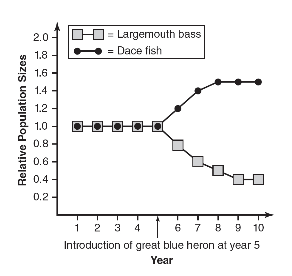
(a) Describe the trophic level of the dace fish in this ecosystem.
(b) Identify the independent variable and the dependent variable in this experiment.
(c) Analyze the data to determine the effect of the introduction of great blue herons on the population sizes of the largemouth bass and the dace fish.
(d) Predict the effect of the introduction of the great blue herons on the algae density in the lake. Justify your prediction.




